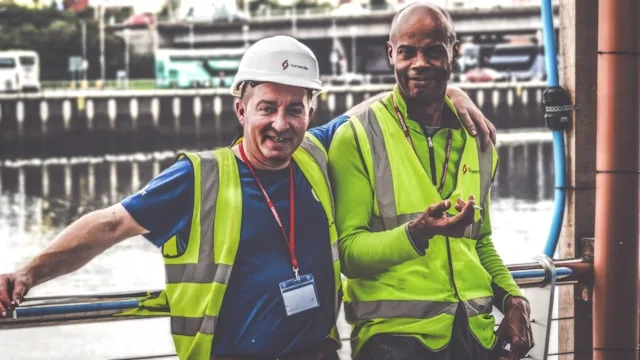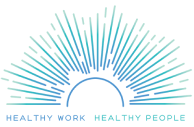Preguntas frecuentes
¿Qué es la Campaña Trabajo Saludable?
La Campaña de Trabajo Saludable (HWC) es una campaña de salud pública enfocada en generar conciencia en los EE. UU. sobre los impactos del estrés laboral en la salud de las personas trabajadoras. Brindamos orientación experta sobre las acciones positivas que las personas y las organizaciones pueden adoptar para promover el trabajo saludable.
La Campaña Trabajo Saludable es un proyecto de la Centro de Epidemiología Social (CSE), una organización sin fines de lucro 501c3.
Cuál es tu misión?
Nuestro objetivo es Compartir conocimientos, herramientas y estrategias con los trabajadores y otras partes interesadas en el lugar de trabajo para reducir las fuentes de estrés en el trabajo y mejorar las condiciones laborales y la salud de los trabajadores. (Obtenga más información aquí).
¿Cuáles son tus metas?
- Acercamiento a los trabajadores con sindicatos, centros de trabajadores y defensores de la seguridad y salud en el trabajo
- Ofrecer orientación y soluciones personalizadas basadas en investigaciones a organizaciones del sector público y privado.
- Desarrollar alianzas estratégicas/una coalición para abogar por la prevención del estrés laboral
¿Qué es el 'trabajo saludable'?
'Trabajo saludable' es un término abreviado para las condiciones de trabajo que minimizan los factores de estrés tóxicos que afectan la salud y la productividad de los trabajadores. El trabajo saludable es respetuoso, justo, más sostenible y promueve la salud y el bienestar. (Consulte los estudios recomendados sobre intervenciones en la organización del trabajo en nuestra página web). Página de investigación para más información.)
¿Cuáles son los beneficios del 'trabajo saludable'?
'Trabajo saludable' beneficia a individuos y organizaciones principalmente al reducir los factores estresantes del trabajo dañinos y mejorar la salud y el bienestar. (Ver ¿Qué es el Trabajo Saludable? para obtener más información.) Una robusta y literatura creciente Proporciona evidencia científica de que las intervenciones para reducir los factores estresantes laborales pueden ser beneficiosas para la salud, el bienestar y la productividad de las personas trabajadoras.
¿Qué es el 'trabajo insalubre'?
'Trabajo insalubre' es un término abreviado para el trabajo organizado de una manera que expone crónicamente a las personas que trabajan a factores estresantes en el trabajo. (Ver ¿Qué es el Trabajo Saludable? para más información.)
¿Qué son los estresores laborales?
Experiencias amenazantes o desafiantes En nuestra vida cotidiana, en el trabajo o en casa, se denominan “factores estresantes”. Provocan una “respuesta de lucha o huida” biológica natural que aumenta nuestra frecuencia cardíaca y respiratoria y libera cortisol y otras hormonas del estrés. Si bien esta “respuesta al estrés” es una experiencia “biopsicosocial” que implica la evaluación cognitiva de una amenaza por parte de un individuo, las fuentes de estrés en el trabajo (“estresores laborales”) no están solo en tu cabeza, son causada por la forma en que se organiza el trabajo y están dispuestos a cambiar.
¿Por qué los factores estresantes del trabajo son "no saludables"?
Cuando estamos crónicamente expuestos Ante los “factores estresantes” en el trabajo, los efectos de la respuesta al estrés a corto plazo se acumulan y pueden provocar “angustia mental” y cambios fisiológicos. Los factores estresantes laborales más comunes incluyen: cargas de trabajo excesivas, falta de control (“tensión laboral”), relaciones hostiles o poco solidarias con supervisores o compañeros de trabajo, desequilibrio entre esfuerzo y recompensa, conflictos entre trabajo y familia, y más.
A largo plazoEl impacto acumulativo de los factores estresantes laborales puede provocar agotamiento y depresión, así como cambios físicos en nuestro cuerpo, incluidos aumentos permanentes de la presión arterial, respuestas inflamatorias que conducen a cambios cardiovasculares e incluso cambios en nuestro metabolismo y sistema nervioso autónomo. aquí para más información.
¿Cuáles son los costos del 'trabajo insalubre' para las personas?
Costos del 'trabajo insalubre' Las personas sufren estrés físico, psicológico, económico y social. El estrés diario de las largas horas de trabajo, las altas exigencias, el escaso control del trabajo, la inseguridad laboral, la falta de equidad o el conflicto entre el trabajo y la familia pueden suponer una amenaza real para la salud, el bienestar e incluso la esperanza de vida (acortando la vida hasta tres años), aumentando el riesgo de sufrir agotamiento, depresión, hipertensión e incluso enfermedades cardíacas. Los costes de estos problemas de salud relacionados con el estrés laboral se están trasladando a las personas en forma de primas y franquicias sanitarias más elevadas, lo que hace que el acceso a la atención sanitaria en Estados Unidos esté más fuera de su alcance que nunca.
Ver Estadísticas e infografías para más información.
¿Cuáles son los costos del 'trabajo insalubre' para las organizaciones?
Costos del 'trabajo insalubre' organizaciones financieramente de varias maneras.
Cuando los trabajadores experimentan estresores psicosociales relacionados con el trabajo, también informan una peor salud física y mental, están menos comprometido, y tienen más probabilidades de venir a trabajar enfermos y trabajar de manera menos efectiva (presentismo), o pueden quedarse en casa y tomar baja por enfermedad (ausentismo). Según algunas estimaciones conservadoras, los costos de atención médica de los factores estresantes laborales son entre el 5 y el 81 por ciento de los costos anuales de atención médica en Estados Unidos (lo que totaliza 180 mil millones de dólares). (Go et al., Ciencias de la gestión, febrero de 2016)
Pero el trabajo insalubre cuesta a las organizaciones Más que el aumento de las primas de atención médica, los costos indirectos adicionales para las empresas – que incluyen los costos del aumento del ausentismo/bajas por enfermedad, la gestión de la discapacidad, la disminución de la productividad en el trabajo (presentismo) y la rotación de personal.- son Se estima que asciende a cientos de miles de millones de dólares. (Jauregui y Schnall. Trabajo insalubre: causas, consecuencias, curas, 2009)
Ver el Caso de negocio para más información.
¿Cuáles son las principales estadísticas que debo conocer sobre el 'trabajo insalubre'?
- Del total de trabajadores que informaron haber experimentado estrés relacionado con el trabajo en el último mes, 57% indicaron haber experimentado impactos negativos a causa de ello.APA, 2023)
- 3 de cada 5 (64%) estadounidenses dicen que el trabajo es una fuente importante de estrés.APA, 2023)
- Aquellos que trabajan más de 11 horas por día tienen de 2 a 3 veces más probabilidades de experimentar depresión. (PO, 2012)
- Las personas con altos niveles de factores estresantes laborales (tensión laboral, desequilibrio entre esfuerzo y recompensa) tienen el doble de probabilidades de pensar en suicidarse que aquellas que no tienen estrés laboral o lo tienen en cantidades limitadas.JPR, 2016)
- 10-20% de todas las enfermedades cardiovasculares (ECV) en la población en edad laboral está relacionada con la forma en que trabajamos. (IJOMEH, 2015)
- Más de 120.000 muertes al año están asociadas con la forma en que las empresas estadounidenses gestionan a sus trabajadores.MS, 2016)
¿Dónde puedo leer más estadísticas sobre el trabajo insalubre?
Echa un vistazo a nuestro Estadísticas e infografías página.
¿Qué investigación ha informado sus afirmaciones?
La Campaña de Trabajo Saludable se compromete a compartir todas nuestras referencias y publicaciones de investigación fundamentales, reconociendo a la gran comunidad mundial de investigadores y organizaciones que han informado nuestra campaña educativa y los recursos relacionados. Nos esforzamos por dar crédito a quien lo merece, así como por asegurarle la sustancia y la validez de esta campaña. Visite nuestra Investigar página para nuestras referencias y otra información esencial.
¿Quién inició esta campaña?
El Centro de Epidemiología Social (CSE), una organización sin fines de lucro con sede en Los Ángeles fundada en 1988, inició el HWC en 2018 para expandir la misión de salud pública del CSE y otras organizaciones dedicadas a mejorar la calidad del trabajo en los EE. UU. Visite nuestro Página Quiénes somos aprender más.
El Centro tiene una relación de larga data con los Centros de Salud Ocupacional y Ambiental (COEH) de UC Irvine y UCLA, y es un miembro activo de la NIOSH Salud total del trabajador® Programa de afiliación, dedicada a proteger y promover la salud y el bienestar de los trabajadores.
¿Quiénes son sus socios?
Vea nuestra creciente lista de socios, que incluye: Colegio Americano de Medicina Ocupacional y Ambiental, Coalición de Mujeres Sindicalistas, Envisia aprendizaje, Lugares de trabajo saludables, Consejo Nacional de Seguridad y Salud Ocupacional, Centro Clínico de Salud Ocupacional, Clínicas de salud ocupacional para trabajadores de Ontario, Inc., Coalición de salud en el lugar de trabajo de Ontario, Joe Robinson/Estrategias de rendimiento óptimo, Conexión PACES, Centro de Investigación y Educación del Sur de California, Programa de Salud y Seguridad Laboral de UCLA, Instituto de Acoso Laboral, y Trabajo seguro.
¿Quién es tu audiencia?
Nuestra audiencia incluye todas las partes interesadas en el trabajo saludable—cualquier persona que se preocupe por el impacto del trabajo en la salud y el bienestar de los trabajadores, las organizaciones y la sociedad, incluidos (pero no limitados a): individuos, organizaciones, organizaciones laborales, profesionales de salud y seguridad ocupacional, defensores de la salud pública, profesionales de la salud , educadores y hacedores de políticas públicas.
¿Cómo comparto mi historia laboral?
Si desea compartir un breve relato de sus experiencias laborales, de forma anónima o indicando su nombre, nos encantaría saberlo. La Campaña Trabajo Saludable está buscando sus historias sobre el trabajo (saludable y no saludable) para compartirlas en healthywork.org (y posiblemente en nuestro contenido multimedia). Contáctenos aprender más.
¿Cuáles son sus objetivos de política pública?
Actualmente nuestros objetivos de políticas públicas se basan en sugerencias, centradas en iniciativas y políticas locales. Visita nuestro Leyes y reglamentos sección de nuestro Recursos para trabajadores y sindicatos página para obtener más ideas sobre la defensa del trabajo saludable dentro y fuera de los EE. UU.
¿Qué puedo hacer para marcar la diferencia?
Usted puede Aprenda sobre el trabajo saludable, evaluar el estrés laboral (para individuos y organizaciones), Únete al movimiento, programar un taller, o Comparte tu historia con nosotros. Visita Soluciones para empleadores, Recursos para trabajadores y sindicatos, o Apoye nuestra campaña para más ideas.
¿Cuáles son los términos y condiciones de uso de este sitio web y materiales?
Puede encontrar nuestro acuerdo de Términos de uso en nuestro Términos y condiciones página. Cuando utiliza nuestro sitio web, acepta estos términos.
¿Cuál es la política de privacidad de este sitio web y sus materiales?
Puede encontrar nuestra política de privacidad en nuestro Intimidad página. En este sentido, y en general, pretendemos asegurarle nuestro máximo respeto por su privacidad.
¿Tiene un descargo de responsabilidad médica?
Si. Los contenidos de este sitio web, tales como texto, gráficos, imágenes, videos, herramientas y otro material contenido en el sitio web ("Contenido"), son solo para fines informativos y no constituyen, ni deben considerarse una sustitución de, Consejo médico.
El Contenido no pretende ser un sustituto del consejo, diagnóstico o tratamiento médico profesional. Siempre busque el consejo de un médico u otro proveedor de salud calificado con cualquier pregunta que pueda tener con respecto a una condición médica. Nunca ignore el consejo médico profesional ni se demore en buscarlo por algo que haya leído en este sitio web. El Sitio y el Contenido se proporcionan "tal cual". La confianza en cualquier información proporcionada por este sitio web es únicamente bajo su propio riesgo.
¿Tiene una versión más corta de esta página?
Si. Por favor, descargue y consulte nuestro Preguntas frecuentes rápidas sobre HWC.






